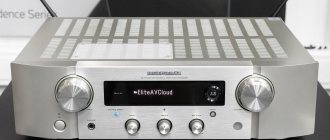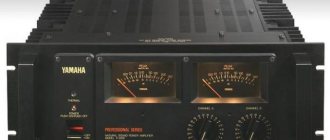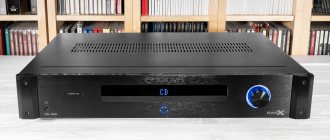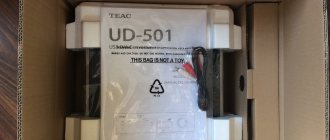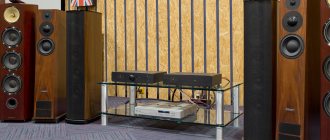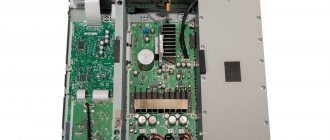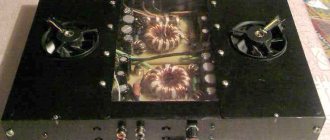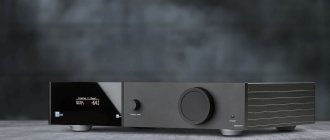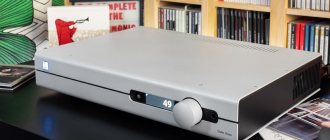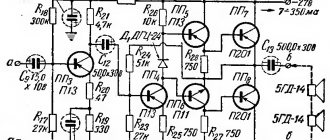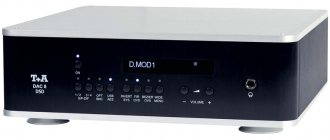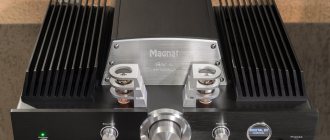Parasound is a well-known manufacturer of power amplifiers. For a long time the company produced only individual components and only 35 years after its founding decided to produce an integrated model. Its modernized version appeared five years later. Actually, we will get to know her. There are few differences, but they are worth understanding.
In preparation for writing this test, I wanted to refresh my knowledge about Parasound by reading again the interview that I was able to interview in 2007 with Richard Schram, the founder of the company (it was published in a magazine, so I can’t give a link to it). Having compared what is stated in it with the materials of the current Parasound website, a number of conclusions can be drawn.
The main thing is that even after 12 years the company is doing well: the business model found in the late 70s continues to work successfully, and Mr. Shram remains its head and owner. Once upon a time, his idea was to fill the gap between the mass and top segments of the Hi-Fi market, offering products with high-end sound at a price accessible to a wide range of buyers. Thanks to the accumulated relationships with audio component manufacturers around the world and excellent knowledge of the needs of music lovers, Parasound continues to be able to produce sought-after products at very competitive prices.
The case has undergone minor changes, but remains just as solid and strong; its austere appearance is enlivened by blue illumination of details. In addition to black, there is also a silver finish option
Interestingly, back then, during the heyday of multi-channel home theater systems, Mr. Schram saw a trend back to stereo, but an integrated amplifier was not yet on the cards. The Parasound brand is associated primarily with power amplifiers, and for 35 years they have formed the core of the range - both for the installation and user divisions. In addition to them, naturally, preamplifiers and other devices were produced, but the first integrated device in the Halo line, after three years of development, appeared only in 2014.
Minor changes
This was an event: Parasound Halo received awards, excellent reviews in the press, and recognition in the audiophile community. And now, five years later, a modernized version of this amplifier was released - HINT 6 (HINT - from Halo INTegrated, 6 - from the new P6 preamplifier, from which the corresponding integrated circuit unit borrowed many circuits).
There are few changes - they are listed in ten points of a brief description of the model. And this is really a small number when compared with the list of main characteristics of the amplifier, which combines a lot of hardware capabilities and functions.
The amplifier is largely designed to work in a DC system to provide high-quality sound from front speakers. Noteworthy are the balanced XLR outputs from the preamplifier and subwoofer. The low pass filter allows you to adjust the signal from all available outputs to the subwoofer, the high pass filter filters the signal both from the output from the preamplifier and from what goes to the speakers
It features a new Burr-Brown analog volume control unit, along with a solid ball-bearing-based knob and an option to set it to an initial level when turned on. The current volume is now shown on the small display located next to it.
When playing music content from a PC via a Type B USB port, driver installation is no longer required, not only for Mac products, but also for computers running Windows 10.
The gain for MC cartridges in the built-in phono stage has also been increased, channel separation has been improved and some cosmetic changes have been made to the appearance.
Parasound HINT 6 - Absolute Integration
We study
The Parasound HINT 6 integrated amplifier, which was a development of the popular Halo model, fully embodies the concept described above. And the “additional” blocks included in it deserve special attention. Let's start with the DAC unit, which is based on a modern dual-channel ES9018K2M Sabre32 Reference series chip from ESS Technology, capable of processing PCM digital streams with parameters up to 32 bit / 384 kHz and DSD up to DSD256. In addition to the usual SPDIF inputs - coaxial and a pair of optical ones, there is a USB type B input, implemented on the SA9227 chip from Savitech. This solution made it possible to broadcast high-resolution audio from a computer running the Windows 10 operating system without installing additional drivers. And if the resolution of the PCM stream received at the SPDIF inputs is limited to 24 bit / 192 kHz, then via USB Parasound HINT 6 is ready to receive digital content with the maximum parameters for the DAC chip - PCM up to 32 bit / 384 kHz and DSD up to DSD256.
The phono preamplifier unit implemented in Parasound HINT 6 also stands out among its competitors. Not only is it capable of working with moving coil (MC) cartridges, along with moving magnet (MM) cartridges, but it also allows the input impedance of MC mode to be varied from 47k ohms to 100 ohms, allowing for better matching of the phono preamp with the cartridge. . Typically, such functions are implemented only in external phono stages.
Speaking about the distinctive features of the Parasound HINT 6, which expand the functionality of the model, it is worth mentioning the adjustable crossovers that serve the outputs from the preamplifier, as well as outputs to active subwoofers. In the first case, a filter with a slope of 12 dB per octave cuts off the low-frequency spectrum (high pass), in the second, a filter with similar characteristics cuts off the high-frequency range (low-pass). At the same time, the crossover cutoff frequencies can be smoothly changed using rotary controls on the rear wall of the amplifier. This functionality can be useful when setting up a trifonic with one or two subwoofers. In this case, the subwoofer crossovers can be disabled. If you do not need these capabilities, then the amplifier crossovers can be excluded from the signal path.
Like any “American”, Parasound HINT 6 is ready to work as part of a universal system for cinema and music. For this, it has so-called bypass inputs - stereo and for two subwoofers. The subwoofers are switched through to the corresponding outputs of the amplifier, and the stereo one is actually the input of the power amplifier, to which the outputs of the front channels of an AV processor or AV receiver can be connected. Thus, the operation of the front pair of acoustics is realized both as part of a home theater surround sound system and as part of a stereo system. Separately, it is necessary to mention the balanced switching of Parasound HINT 6. There is such an input on a pair of XLR connectors, an output from a pre-amplifier and a separate output for connecting an active subwoofer.
Compared to its predecessor Halo, the Parasound HINT 6 amplifier has a new volume control unit. It is now implemented not on a servo-driven potentiometer, like Halo and most competitors, but on a resistive matrix controlled by a Burr Brown controller from Texas Instruments. This solution allowed us to achieve minimal channel imbalance and improve the crosstalk attenuation between channels when adjusting the volume. As a bonus, the new volume control made it possible to display the gain level in conventional units from 0 to 99 on a small information display to the left of the large adjustment knob. The brightness of the display can be changed up to complete shutdown. In addition, this volume control made it possible to program the gain level, which will be automatically set when the component is turned on, in order to avoid unpleasant surprises.
Next to the large volume knob is a rotary input switch and a channel balance control. To indicate the currently active input, there is a line of LEDs at the bottom of the facade. On the left side of the front panel there are knobs for a switchable tone control and a subwoofer level control. There is also a minijack for connecting headphones and an analog AUX input on the same type of connector.
The interior space of the Parasound HINT 6 amplifier is filled quite tightly. On the right side there is a large toroidal power transformer in a solid metal screen, which compensates for possible electromagnetic interference to the remaining amplifier blocks. To the left of it are mounted two boards with separate power supplies for each channel and power amplifiers equipped with impressive cast radiators for cooling the output stages. The total capacitance of the power supply filter capacitors is an impressive 40 thousand microfarads. The amplifier circuit solutions here are similar to the Halo model and are based on the designs of John Curl. Pre-amplifier stages combine field-effect transistors (JFETs) and bipolar transistors (BJTs) to operate in areas of the circuit where their benefits are most evident. The output stages, which combine Class A operation at low power levels with a transition to A/B when the volume increases, employ MOSFET drivers and three high-power bipolar transistors in each arm. Such a hot inside of the amplifier requires special control and protection measures. Parasound HINT 6 implements a relay automatic protection system against load short circuits and overheating.
Solid foundation
At its core, Parasound HINT 6 is the already familiar Halo Integrated with its power amplification stage, developed by specialist John Curl, with whom the company has been collaborating for many years. This unit operates in class A/AB: at low volume - in A, and as it increases, there is an automatic transition to class AB. The threshold point can be at the level of several watts, and for more powerful models it can reach two dozen.
An input to this stage is provided for third-party compatible components, which allows, in particular, to use this amplifier in a home theater system for sounding the front channels.
The preamplifier section has a tone block and a switchable MM/MC phono preamplifier. A distinctive feature of HINT 6 (like its predecessor) is the customizable subwoofer and preamplifier outputs for a 2.1-channel system. On the rear panel there are adjustments for switchable low- and high-pass filters, allowing you to optimally distribute the signal between the speakers, which is especially important when using small bookshelf speakers. The subwoofer volume can be adjusted using the small round knob on the front panel.
This Parasound also has a built-in DAC based on the ESS Sabre32 Reference ES9018K2M chip - the same as its predecessor, but the HINT 6 now has another optical input. There is also a high-quality 3.5 mm headphone output on the front panel with its own Texas Instruments TPA6120 amplifier circuit.
Integrated amplifier PARASOUND HALO INTEGRATED (HINT)
Those who are guided by the principle “measure twice, cut once” are Parasound and its key figures: entrepreneur Richard Schram and engineer John Curl. Parasound does not change models every year, but prefers to act rarely and accurately.
The Halo Integrated amplifier, which recently appeared in our showroom, represents the evolution of the Halo series of two-block amplifiers, but at the same time marks the first appearance of an integrated amplifier in the Parasound line since 1986!
| Available in two design options. Ours was black. |
It is curious that although Parasound has always been and is an American company, although aimed not only at the local but also at the world market, its amplifiers have never been manufactured in the USA. At the very beginning, most of the components were made in Japan, and finished products were assembled in Taiwan, but soon production moved to Taiwan completely. As Richard Schram says, he has been working with three Taiwanese contractors for about 30 years and they do not lose interest in very difficult orders from a small manufacturer of hi-fi equipment.
Halo Integrated generally repeats the circuit ideology of the Halo series, but at the same time it is not a P5 preamp and an A23 power amplifier combined in one case. Despite the external similarity with the P5, the new integrated device has more flexible functional equipment and a completely different digital part on the ESS Sabre32 chip. The output stage on bipolar transistors operates in A/AB mode, the preliminary and driver stages are traditionally implemented on field-effect transistors.
Appearance
On the front panel of the device, made in the traditional design of the HALO line, the most unusual decoration can be called bass and treble tone controls - this is a rarity in a modern amplifier. To add to some surprises, you can add the presence of an output to headphones, and in the “3.5 mm mini-jack” format. There is also a subwoofer output level control here, if you want to use a sub along with the main speakers.
Options and Features
In the technical description from the manufacturer, I was pleasantly surprised by the stated power of the amplifier - 160 W per channel at a load of 8 ohms - and the corresponding powerful power supply with a powerful toroidal transformer and capacitors with a total capacity of 40,000 microfarads.
On the rear panel of the amplifier, in addition to the output terminals and a set of balanced and unbalanced connectors, there is a specialized subwoofer output and digital switching for the built-in 32-bit/384 kHz DAC. There is also an MM-MC phono input, which we used with success when connecting a Pro-Ject turntable. There is also a pass-through input for operation as part of a home theater system, when all adjustments are transferred to the AV receiver or processor. We can say that in terms of equipment, Parasound HINT turned out to be more advanced than its competitors in this price category.
| There are even two load resistance options at the MC input | Five analog inputs |
| To use HINT in a home theater, the output of an external receiver or processor should be connected to the PA input (to the front), you can also take the LFE signal to two pass-through inputs (1, 2) of subwoofers | Two subwoofer outputs and their adjustments |
| Trigger control, IR headers and DAC inputs | Balanced input (bottom) and outputs (top) |
| Universal power supply | Remote controller |
Operation and listening
The amplifier was warmed up in the cabin for about ten days. The character of the sound turned out to be similar to the company's previous devices of the HALO series. After warming up, the sound of the device softened somewhat, which affected the sound character for the better when listening to files from the USB input. To work properly as a USB Audio device, you should install special drivers from Parasound before connecting to a Windows PC.
When listening to CDs from an external Goldmund player, the tested amplifier showed extraordinary dynamics in rock compositions and excellent detail in jazz tracks. Works of classical music also sounded large-scale and tireless. The connection was made both through the analog input of the amplifier and through the digital coaxial input. It turned out to be quite difficult to give preference to one of the options, which certainly speaks of the high quality of the built-in DAC in the amplifier, since the DAC in the Goldmund player cannot be classified as weak. The choice of connection method will remain with the consumer.
The amplifier was connected to the Sonus Faber Liuto and Focal Aria 936 acoustic systems. The most interesting combination, in our opinion, was with the Liuto.
Bonuses
How can I use the additional functionality of Parasound HINT? The ability to connect a subwoofer with adjustable cutoff frequency will be interesting both in systems with small-sized speakers and, if necessary, to add bass in sets with floor-standing speakers. It is unlikely that the tone controls will be idle, which may come in handy when playing back not very high-quality recordings. When the tone block was turned on, there were no noticeable sound distortions.
When listening to vinyl records, the built-in phono stage proved to be a device that allows us to understand the potential of vinyl media as one of the still in demand sources of high-quality music reproduction.
When connecting a Pro-Ject player with an inexpensive Ortofon 2M RED MM head installed, the sound of the path acquired softness and delicacy in quiet passages and was characterized by a lack of harshness when listening to dynamic rock compositions, which characterizes the built-in phono stage only on the positive side.
The headphone output is implemented in the amplifier using a 3.5 mm mini-jack, which we found not very convenient for home listening. Connecting Oppo and Audio-Technica headphones, both through adapters and without them, after a short listening showed that the built-in amplifier sounds good, but compared to a separate headphone amplifier, for example, the Creek OBH-21 loses in detail.
Summary
The Parasound HINTT amplifier turned out to be a very outstanding model both in terms of equipment and its sound characteristics. It will not be easy for possible competitors to repeat the achievements of Parasound, especially since the retail price was not too high. All the salon specialists agreed that the device at least deserves the close attention of experienced music lovers or those who are just planning to create a music system at home.
The test was carried out in a listening room using the following accompanying equipment: AC Sonus Faber Liuto and Focal Aria 936; Project Debut Carbon turntable; CD player Goldmund Eidos 18; Purist Audio Design cables.
Musical material: Diana Krall (XRCD 24 Bit Japan Edition), Eagles 'Hotel California' (SACD), Dire Straits 'On Every Street' (CD), vinyl - Pink Floyd Division Bell (180g), Depeche Mode 'Violator'.
For those who want to improve their English, two videos from the manufacturer:
Bob MacDonald (Director of Development) talks about the amplifier:
Very long review showing features
Smooth yet detailed sound
When partners tested the Parasound HINT 6, they used components of a comparable price level: the Lyngdorf CD-2 CD player and interesting Q Acoustics Concept 300 bookshelf speakers.
The sound quality, as one would expect, turned out to be the best with a balanced source connection - more detailed, sophisticated, with a voluminous and large-scale stage filled with “air”. It should be noted that when selecting the RCA input, the volume does not change and the tonal balance is just as neutral.
The DAC built into the amplifier works perfectly: when connecting a CD player via the optical input, the sound is only slightly inferior to that obtained with an XLR connection. This is not surprising, given that HINT 6 uses a more modern digital-to-analog conversion chip than the source. Why is he not the best in this system at all? Perhaps the optical connection should be taken into account, and Lyngdorf is famous for its developments, so the company’s specialists managed to get the most out of the chip at their disposal. However, the impressions below are based on a balanced connection between the CD player and the amplifier.
And they are the best. HINT 6 has a smooth, coherent, fluid sound while at the same time being detailed, organized and tonally balanced. It is good to check the accuracy of the material on the CD “JS Bach. Sacred Arias & Cantatas. David Daniels. The soloist's countertenor sometimes appears as a female vocal if the equipment does not scrupulously build its overtones.
There are more buttons and indicators, and the display allows you to set the volume more clearly
In this case, there is not the slightest doubt that this high voice belongs to a man, and such an unusual style of singing was formed as a result of professional work on it. However, you are unlikely to think about it - the masterful performance of church hymns captivates and puts you in a special mood. Ancient instruments on a large stage with unusual sounds beautifully frame the artist’s clearly focused image.
Excellent microdynamics and the ability to shape acoustic space are demonstrated by the playback of CD “S. Rachmaninov. Liturgy of St. John Chrysostom." The recording was made in the Assumption Cathedral in Smolensk - and its volume is really felt when listening. The choir performing the “Liturgy of St. John Chrysostom” is detailed down to the individual voices. A cappella singing sounds very melodic and intelligible - both in the quietest moments and during emotional peaks of volume.
Easier-to-understand music is presented just as flawlessly and, most importantly, excitingly. In the concert album “Toute la musique...” by Patricia Kaas, the scene is depicted very authentically: the foreground is given to the soloist, the instruments organically complement her, and the listener finds himself in a large crowd gathered in the hall. The singer's voice is full of characteristic nuances, it is stunningly articulate, lively, and exciting. Pulling blues rhythms are just as good as the heavier and more energetic or light and groovy ones that replace them.
And HINT 6's ability to keep the sound under control, but with soft gloves, provides the compositions of Muse's CD "Black Holes and Revelations" with a dizzying combination of scale, dynamics, purity of melodic lines, elastic rhythms and clearly focused convex vocals.
